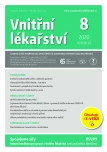Physical activity in the treatment of obesity in practice
Authors:
Martin Matoulek 1; Natálie Cibulková 1,2,3; Ondřej Kádě 1; Marcela Hašpicová 4
Authors‘ workplace:
3. interní klinika – klinika endokrinologie a metabolismu 1. LF UK a VFN Praha
1; FTVS Praha – Katedra zdravotní TV a tělovýchovného lékařství, Praha
2; 3. klinika rehabilitačního lékařství 1. LF UK a VFN Praha
3; ORP centrum, Praha
4
Published in:
Vnitř Lék 2020; 66(8): 483-488
Category:
Main Topic
Overview
Physical activity is an integral part of the obesity treatment. Curiously, even among health professionals, the evaluation of obesity treatment persists only based on weight loss. However, the treatment of obesity is not only a simple weight loss, but above all the treatment of associated diseases such as hypertension, diabetes, dyslipidemia, etc. Physical fitness is very rarely assessed, although it best predicts the future and reduces mortality from all causes. It is mainly a cardiovascular disease, where it is shown that the parameter VO2Max is the strongest predictor of not only cardiovascular mortality. The specifics of the prescription of physical activity bring with it the presence not only of diabetes, hypertension and cardiovascular diseases, but also osteoarthritis, possibly undergoing bariatric surgery. To objectify physical activity, including subjective symptoms, it is appropriate to use modern methods of telemedicine, which is the future in the treatment of not only obesity.
Keywords:
obesity – Physical activity – Physical fitness – diabetes – hypertension – osteoarthritis – bariatric surgery – telemedicine.
Sources
1. Barry VW, et al. Fitness vs. fatness on all‑cause mortality: a meta‑analysis. Prog Cardiovasc Dis, 2014; 56(4): 382–390.
2. Matoulek M, et al. Modulation of Energy Intake and Expenditure Due to Habitual Physical Exercise. Curr Pharm Des, 2016; 22(24): 3681–3699.
3. Stoa EM, et al. High‑intensity aerobic interval training improves aerobic fitness and HbA1c among persons diagnosed with type 2 diabetes. Eur J Appl Physiol, 2017; 117(3): 455–467.
4. Sedlock DA, Fissinger JA, Melby CL, Effect of exercise intensity and duration on postexercise energy expenditure. Med Sci Sports Exerc, 1989; 21(6): 662–666.
5. Soupal J, et al. Glycemic Outcomes in Adults With T1D Are Impacted More by Continuous Glucose Monitoring Than by Insulin Delivery Method: 3 Years of Follow‑Up From the COMISAIR Study. Diabetes Care, 2020; 43(1): 37–43.
6. Soroush A, et al. Effects of a 6-Month Walking Study on Blood Pressure and Cardiorespiratory Fitness in U.S. and Swedish Adults: ASUKI Step Study. Asian J Sports Med, 2013; 4(2): 114–124.
7. Sousa Junior AE. et al. Physical Activity Counseling for Adults with Hypertension: A Randomized Controlled Pilot Trial. Int J Environ Res Public Health, 2020; 17(17).
8. Matoulek M, Svacina S, Lajka J. (The incidence of obesity and its complications in the Czech Republic). Vnitr Lek, 2010; 56(10): 1019–1027.
9. Stenehjem JS, Hjerkind KV, Nilsen TIL. Adiposity, physical activity, and risk of hypertension: prospective data from the population‑based HUNT Study, Norway. J Hum Hypertens, 2018; 32(4): 278–286.
10. Kruk PJ, Nowicki M. Effect of the physical activity program on the treatment of resistant hypertension in primary care. Prim Health Care Res Dev, 2018; 19(6): 575–583.
11. Bliddal H, Leeds AR, Christensen R. Osteoarthritis, obesity and weight loss: evidence, hypotheses and horizons – a scoping review. Obes Rev, 2014; 15(7): 578–586.
12. Kanavaki AM, et al. Barriers and facilitators of physical activity in knee and hip osteoarthritis: a systematic review of qualitative evidence. BMJ Open, 2017; 7(12): e017042.
13. Baillot A, et al. Impact of excess skin from massive weight loss on the practice of physical activity in women. Obes Surg, 2013; 23(11): 1826–1834.
14. Castello V, et al. Impact of aerobic exercise training on heart rate variability and functional capacity in obese women after gastric bypass surgery. Obes Surg, 2011; 21(11): 1739–1749.
15. Stegen S, et al. Physical fitness in morbidly obese patients: effect of gastric bypass sur ‑ gery and exercise training. Obes Surg, 2011; 21(1): 61–70.
16. Brown JD, et al. Description, utilisation and results from a telehealth primary care weight management intervention for adults with obesity in South Carolina. J Telemed Telecare, 2020; 26(1–2): 28–35.
17. Lee CH, et al. Mobile health, physical activity, and obesity: Subanalysis of a randomized controlled trial. Medicine (Baltimore), 2018; 97(38): e12309.
18. Pelosi P, Gregoretti C. Perioperative management of obese patients. Best Pract Res Clin Anaesthesiol, 2010; 24(2): 211–225.
Labels
Diabetology Endocrinology Internal medicineArticle was published in
Internal Medicine

2020 Issue 8
Most read in this issue
- Dialysis patient in internal medicine inpatient ward
- Obesity-associated changes in drug pharmacokinetics
- Heparin induced thrombocytopenia and up to date options of treatment – review of literature
- Danger of the sea‑complications After Scorpion Fish Attack
